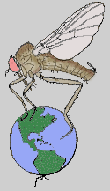
| Home | Family Key | Identification Table | |||
![]()
Diptera Associated with Livestock Dung
Horn fly Haematobia irritans (L.)
 |
Haematobia irritans is distributed nearly worldwide in the lower latitudes, but is not found in Australia or most of the Afrotropical Region. It was introduced into North America from Europe in the late 1800's and became established in southern Canada by the turn of the century.
Horn fly adults typically occur on cattle, but may infest other livestock such as horses. Adults spend most of their life on the host animal, congregating on the back and shoulders [fig.] or on the underparts during hot days. Unlike stable flies, adults will not bite man. Adult horn flies average 5 mm long and are about 1/2 to 2/3 the size of a typical housefly. They are charcoal gray in colour with 2 dark stripes on the thorax and a few diffuse spots on the top of the abdomen [fig.]. Like stable flies the mouthparts are visibly extended forwards from the head as a piercing proboscis [fig.], but the palps are longer than 1/2 the length of the proboscis.
Eggs are without a terminal respiratory horn as seen in the face fly [fig.].
Larvae (3rd instars) are yellowish white maggots about 7 mm long. They are cylindrical and taper anteriorly. Two narrowly separated "D"-shaped spiracles are located on the rear end. Each is outlined by a thin, dark band, with 3 sinuous-shaped slits surrounding a button located towards the inner edge [fig.].
Puparia are dull reddish brown and 3 - 4 mm long. The respiratory horns found along the posterior border of the 4th segment in most other muscid species are minute and difficult to see. The posterior spiracles are black with 3 sinuous-shaped yellow slits; the spiracles are "D"-shaped and narrowly separated from each other [fig.].
Horn flies occur in open pastures and rangeland. Adults emerge in the spring and spend almost their entire lives among the hair of cattle [fig.]. Both sexes bite and may feed up to 40 times per day. Females require blood meals for egg production and can lay several hundred eggs during their lifespan. They leave the host briefly to lay eggs on fresh undisturbed cattle manure. Larvae complete development within the pat, and pass through 3 instars within 1 to 2 weeks [fig.]. Mature larvae move below the pats into the soil to pupariate and emerge as adults 1 to 2 weeks later. The entire life cycle from egg to adult is completed within 2 to 4 weeks, and 3 to 4 generations may occur throughout the summer. Horn flies overwinter as puparia beneath cow pats and emerge the next spring as adults.
Damage, Economic Impact & Management:
Persistent blood feeding on cattle by horn flies causes irritation and bleeding sores. Cattle spend less time grazing. Large numbers of flies in densities of 500 to 1000 per animal or greater will result in much lower weight gains and milk yields.
Current management practices primarily involve applying pesticides to cattle.
More detailed information on the economic impact and management of horn flies can be found at the following sites:
Filth fly web pages developed by
J.M. Cumming and B.E. Cooper
First published on the Internet in 1998
Last updated 18 May 2006 by J.M. Cumming and G.D. Murray
![]()
